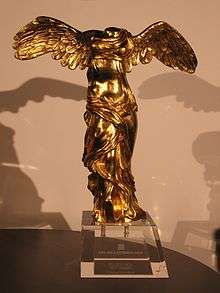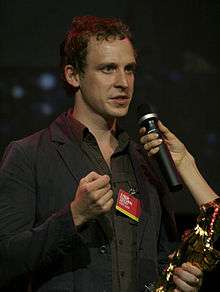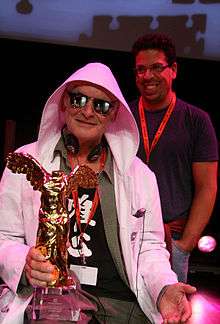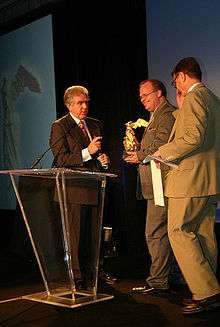Prix Ars Electronica

The Prix Ars Electronica is one of the most important yearly prizes in the field of electronic and interactive art, computer animation, digital culture and music. It has been awarded since 1987 by Ars Electronica (Linz, Austria).
In 2005, the Golden Nica, the highest prize, was awarded in six categories: "Computer Animation/Visual Effects," "Digital Musics," "Interactive Art," "Net Vision," "Digital Communities" and the "u19" award for "freestyle computing." Each Golden Nica came with a prize of €10,000, apart from the u19 category, where the prize was €5,000. In each category, there are also Awards of Distinction and Honorary Mentions.

The Golden Nica is replica of the Greek Nike of Samothrace. It is a handmade wooden statuette, plated with gold, so each trophy is unique: approximately 35 cm high, with a wingspan of about 20 cm, all on a pedestal. "Prix Ars Electronica" is a phrase composed of French, Latin and Spanish words, loosely translated as "Electronic Arts Prize."
Golden Nica winners
Computer animation / film / vfx
The "Computer Graphics" category (1987–1994) was open to different kinds of computer images. The "Computer Animation" (1987–1997) was replaced by the current "Computer Animation/Visual Effects" category in 1998. New York artist and musician John Fekner received honorary awards for Concrete People and The Last Days of Good and Evil in 1987 and 1988.
Computer Graphics
- 1987 "Figur10" by Brian Reffin Smith, UK
- 1988 "The Battle" by David Sherwin, US
- 1989 "Gramophone" by Tamás Waliczky, HU
- 1990 "P-411-A" by Manfred Mohr, Germany
- 1991 "Having encountered Eve for the second time, Adam begins to speak" by Bill Woodard, US
- 1992 "RD Texture Buttons" by Michael Kass and Andrew Witkin, US
- 1993 "Founders Series" by Michael Tolson, US
- 1994 "Jellylife / Jellycycle / Jelly Locomotion" by Michael Joaquin Grey, US
Computer Animation
- 1987 "Luxo jr." by John Lasseter, US
- 1988 "Red's Dream" by John Lasseter, US
- 1989 "Broken Heart" by Joan Staveley, US
- 1990 "Footprint" by Mario Sasso and Nicola Sani, IT
- 1991 "Panspermia" by Karl Sims, US
- 1992 "Liquid Selves / Primordial Dance" by Karl Sims, US
- 1993 "Lakmé" by Pascal Roulin, BE
- 1994 "Jurassic Park" by Dennis Muren, Mark Dippé and Steve Williams, US/CA
- Distinction: "Quarxs" by Maurice Benayoun, FR
- Distinction: "K.O. Kid" by Marc Caro, FR
- 1995 "God's Little Monkey" by David Atherton and Bob Sabiston, US
- 1996 "Toy Story" by John Lasseter, Lee Unkrich and Ralph Eggleston, US
- 1997 "Dragonheart" by Scott Squires, Industrial Light & Magic (ILM), US
Computer Animation/Visual Effects

- 1998 The Sitter by Liang-Yuan Wang, TW
- Titanic by Robert Legato and Digital Domain, US
- 1999 Bunny by Chris Wedge, US
- What Dreams May Come by Mass Illusions, POP, Digital Domain, Vincent Ward, Stephen Simon and Barnet Bain, US
- 2000 Maly Milos by Jakub Pistecky, CA
- Maaz by Christian Volckman, FR
- 2001 Le Processus by Xavier de l’Hermuzičre and Philippe Grammaticopoulos, FR
- 2002 Monsters, Inc. by Andrew Stanton, Lee Unkrich, Pete Docter and David Silverman, US
- 2003 Tim Tom by Romain Segaud and Cristel Pougeoise, FR
- 2004 Ryan by Chris Landreth, US.
- Distinction: Parenthèse from Francois Blondeau, Thibault Deloof, Jérémie Droulers, Christophe Stampe, France
- Distinction: Birthday Boy from Sejong Park, Australia
- 2005 Fallen Art by Tomek Baginski, Poland.
- Distinction: The Incredibles from Pixar
- Distinction: City Paradise by Gaëlle Denis (UK), Passion Pictures (FR)
- 2006 458nm by Jan Bitzer, Ilija Brunck, Tom Weber, Filmakademie Baden-Württemberg, Germany.
- Distinction: Kein platz Für Gerold by Daniel Nocke / Studio Film Bilder, Germany
- Distinction: Negadon, the monster from Mars, by Jun Awazu, Japan
- 2007 Codehunters by Ben Hibon, (UK)
- 2008 Madame Tutli-Putli by Chris Lavis, Maciek Szczerbowski. (Directors), Jason Walker (Special Visual Effects), National Film Board of Canada
- 2009 HA'Aki by Iriz Pääbo, National Film Board of Canada
- 2010 Nuit Blanche by Arev Manoukian (Director), Marc-André Gray (Visual Effects Artist), National Film Board of Canada
- 2011 Metachaos by Alessandro Bavari (IT)
- 2012 Rear Window Loop by Jeff Desom (LU)
- Distinction: Caldera by Evan Viera/Orchid Animation (US)
- Distinction: Rise of the Planet of the Apes by Weta Digital (NZ)/Twentieth Century Fox
- 2013 Forms by Quayola (IT), Memo Akten (TR)
- Distinction: Duku Spacemarines by La Mécanique du Plastique (FR)
- Distinction: Oh Willy… by Emma De Swaef (BE), Marc James Roels (BE) / Beast Animation
Digital Music
This category is for those making electronic music and sound art through digital means. From 1987 to 1998 the category was known as "Computer music." Two Golden Nicas were awarded in 1987, and none in 1990. There was no Computer Music category in 1991.
- 1987 - Peter Gabriel and Jean-Claude Risset
- 1988 - Denis Smalley
- 1989 - Kaija Saariaho
- 1990 - None
- 1991 - Category omitted
- 1992 - Alejandro Viñao
- 1993 - Bernard Parmegiani
- 1994 - Ludger Brümmer
- 1995 - Trevor Wishart
- 1996 - Robert Normandeau
- 1997 - Matt Heckert
- 1998 - Peter Bosch and Simone Simons (joint award)
- 1999 - Aphex Twin (Richard D. James) and Chris Cunningham (joint award)
- 2000 - Carsten Nicolai
- 2001 - Ryoji Ikeda
- 2002 - Yasunao Tone
- 2003 - Ami Yoshida, Sachiko M and Utah Kawasaki (joint award)
- 2004 - Thomas Köner
- 2005 - Maryanne Amacher
- 2006 - Eliane Radigue
- 2007 - Mashiro Miwa
- 2008 - Reactable by Sergi Jordà (ES), Martin Kaltenbrunner (AT), Günter Geiger (AT) and Marcos Alonso (ES)
- 2009 - Speeds of Time versions 1 and 2 by Bill Fontana (US)
- 2010 - rheo: 5 horizons by Ryoichi Kurokawa (JP)
- 2011 - Energy Field by Jana Winderen (NO)
- 2012 - "Crystal Sounds of a Synchrotron" by Jo Thomas (GB)
- 2013 - frequencies (a) by Nicolas Bernier (CA)
- Distinction: SjQ++ by SjQ++ (JP)
- Distinction: Borderlands Granular by Chris Carlson (US)
Hybrid art
- 2007 - Symbiotica
- 2008 - Pollstream - Nuage Vert by Helen Evans (FR/UK) and Heiko Hansen (FR/DE) HeHe
- 2009 - Natural History of the Enigma by Eduardo Kac (US)
- 2010 - Ear on Arm by Stelarc (AU)
- 2011 - May the Horse Live in me by Art Orienté Objet (FR)
- 2012 - "Bacterial radio" by Joe Davis (US)
- 2013 - Cosmopolitan Chicken Project, Koen Vanmechelen (BE)
[the next idea] voestalpine Art and Technology Grant
- 2009 - "Open_Sailing" by Open_Sailing Crew[1] led by Cesar Harada.
- 2010 - "Hostage" by [Frederik De Wilde].[2]
- 2011 - Choke Point Project by P2P Foundation (NL).[3]
- 2012 - qaul.net - tools for the next revolution by Christoph Wachter & Mathias Jud[4]
- 2013 - Hyperform by Marcelo Coelho (BR), Skylar Tibbits (US), Natan Linder (IL), Yoav Reaches (IL)
- Honorary Mentions: GravityLight by Martin Riddiford (GB), Jim Reeves (GB)[5]
Interactive Art

Prizes in the category of interactive art have been awarded since 1990. This category applies to many categories of works, including installations and performances, characterized by audience participation, virtual reality, multimedia and telecommunication.
- 1990 - "Videoplace" installation by Myron Krueger
- 1991 - "Think About the People Now" project by Paul Sermon
- 1992 - "Home of the Brain" installation by Monika Fleischmann and Wolfgang Strauss
- 1993 - "Simulationsraum-Mosaik mobiler Datenklänge (smdk)" installation by Knowbotic Research
- 1994 - "A-Volve" environment by Christa Sommerer and Laurent Mignonneau
- 1995 - the concept of Hypertext, attributed to Tim Berners-Lee
- 1996 - "Global Interior Project" installation by Masaki Fujihata
- 1997 - "Music Plays Images X Images Play Music" concert by Ryuichi Sakamoto and Toshio Iwai
- 1998 - "World Skin, a Photo Safari in the Land of War" installation by Jean-Baptiste Barrière and Maurice Benayoun
- 1999 - "Difference Engine #3" by construct and Lynn Hershman
- 2000 - "Vectorial Elevation, Relational Architecture #4" installation by Rafael Lozano-Hemmer
- 2001 - "polar" installation by Carsten Nicolai and Marko Peljhan
- 2002 - "n-cha(n)t" installation by David Rokeby
- 2003 - "Can You See Me Now?" participatory game by Blast Theory and Mixed Reality Lab
- 2004 - "Listening Post" installation by Ben Rubin and Mark Hansen
- 2005 - "MILKproject" installation and project by Esther Polak, Ieva Auzina and RIXC - Riga Centre for New Media Culture
- 2006 - "The Messenger" installation by Paul DeMarinis
- 2007 - "Park View Hotel" installation by Ashok Sukumaran
- 2008 - Image Fulgurator by Julius von Bismarck (Germany)
- 2009 - Nemo Observatorium by Laurence Malstaf (Belgium)
- 2010 - The Eyewriter by Zachary Lieberman, Evan Roth, James Powderly, Theo Watson, Chris Sugrue, Tempt1
- 2011 - Newstweek by Julian Oliver (NZ) and Danja Vasiliev (RU)
- 2012 - "Memopol-2" by Timo Toots (EE)
- 2013 - Pendulum Choir By Michel Décosterd (CH), André Décosterd (CH)
- Distinction - Rain Room by rAndom International (GB)
- Distinction - Voices of Aliveness by Masaki Fujihata (JP)
Internet-related categories
In the categories "World Wide Web" (1995 – 96) and ".net" (1997 – 2000), interesting web-based projects were awarded, based on criteria like web-specificity, community-orientation, identity and interactivity. In 2001, the category became broader under the new name "Net Vision / Net Excellence", with rewards for innovation in the online medium.
World Wide Web
- 1995 - "Idea Futures" by Robin Hanson
- 1996 - "Digital Hijack" by etoy
- Second prizes: HyGrid by SITO and Journey as an exile
.net
- 1997 - "Sensorium" by Taos Project
- 1998 - "IO_Dencies Questioning Urbanity" by Knowbotic Research
- 1999 - Linux by Linus Torvalds
- 2000 - In the Beginning... Was the Command Line (excerpts) by Neal Stephenson
Net Vision / Net Excellence
- 2001 - "Banja" by Team cHmAn and "PrayStation" by Joshua Davis
- 2002 - "Carnivore" by Radical Software Group and "They Rule" by Josh On and Futurefarmers
- 2003 - Habbo Hotel and "Noderunner" by Yury Gitman and Carlos J. Gomez de Llarena
- 2004 - Creative Commons
- 2005 - "Processing" by Benjamin Fry, Casey Reas and the Processing community
- 2006 - "The Road Movie" by exonemo
Digital Communities

A category begun in 2004 with support from SAP (and a separate ceremony in New York City two months before the main Ars Electronica ceremony) to celebrate the 25th birthday of Ars Electronica. Two Golden Nicas were awarded.
- 2004 - Wikipedia and "The World Starts With Me"
- 2005 - "Akshaya", an information technology development program in India
- Distinction: Free Software Foundation (USA) and Telestreet - NewGlobalVision (Italy)
- 2006 - canal*ACCESSIBLE
- Distinction:
- Codecheck (Roman Bleichenbacher CH)
- Proyecto Cyberela – Radio Telecentros (CEMINA)
- Honorary Mentions:
- Arduino (Arduino)
- Charter97.org – News from Belarus
- CodeTree
- MetaReciclagem
- Mountain Forum
- Northfield.org
- Pambazuka News (Fahamu
- Semapedia
- stencilboard.at (Stefan Eibelwimmer (AT), Günther Kolar (AT))
- The Freecycle Network
- The Organic City
- UgaBYTES Initiative (UgaBYTES Initiative (UG))
- Distinction:
- 2007 - Overmundo
- 2008 - 1kg more
- Distinction: PatientsLikeMe and Global Voices Online
- 2009 - HiperBarrio by Álvaro Ramírez and Gabriel Jaime Vanegas
- 2010 - Chaos Computer Club
- 2011 - Fundacion Ciudadano Inteligente
- Distinction:
- 2012 - Syrian people know their way
- 2013 - El Campo de Cebada by El Campo de Cebada (ES)
- Distinction: Refugees United by Christopher Mikkelsen (DK), David Mikkelsen (DK)
- Distinction: Visualizing Palestine by Visualizing Palestine (PS)
References
- ↑ "Prix 2009". Retrieved 25 September 2010.
- ↑ "Prix 2010". Retrieved 20 February 2011.
- ↑ "Prix 2011". Retrieved 13 July 2011.
- ↑ http://archive.aec.at/#43506. Retrieved 9 September 2013. Missing or empty
|title=(help) - ↑ http://www.aec.at/prix/en/gewinner/#nextidea. Retrieved 9 September 2013. Missing or empty
|title=(help)
External links
| Wikimedia Commons has media related to Prix Ars Electronica. |
- Prix Ars Electronica
- Past winners
- Past winners (in german, more detailed)
- Prix Ars Electronica 1987-1990 (German)